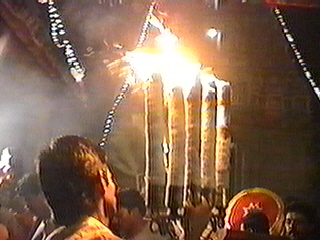Abodes of Ganesha
Temples of Tamilnadu
|

The Agamas - Scriptures related to Temple Traditions
Beliefs and Legends >>Scriptures
The word Agama means tradition. The Agamas are a body of ancient Indian texts dealing with all rituals and ceremonies to be observed in temples. The Agamas deal with rules as to how each iconic representation of divinity (archa murthy) is to be conceived, constructed and worshipped.
Agamas refer to three essential requirements for a pilgrimage town - Stala, theertham and murthy. Stala refers to the temple, theertham, to the temple tank murthy, the deity worshipped. A temple may also be associated with trees - stala vriksham. The Kadamba tree for instance is the stala vriksham at the Madurai Meenakshi Sundareswarar temple, and the banyan tree, the stala vriksham at Tiruvalankaadu. A lone banyan tree adorns the spacious courtyard of the Ratnasabha at Tiruvalankadu, which is believed to have been a forest of banyan trees once.
Elaborate rules have been laid out in the Agamas and in the Silpa Sastras (the science of sculpture) describing the quality requirements of the places where temples are to be built, the kind of images to be installed, the materials from which they are to be made, their dimensions, proportions, air circulation, lighting in the temple complex etc. The Manasara and Silpasara are some of the works dealing with these rules. The rituals followed in worship services each day, also follow rules laid out in the agamas.
Thus, the Agamas deal with the philosophy and spiritual knowledge behind the worship of the deity, the yoga and mental discipline required for this worship, the rules for constructing temples and sculpting images, and the rules pertaining to conduct of worship services and festivals.
The Saiva Agama has led to the Saiva Siddhanta philosophy in South India and to the Pratyabhijna system of Kashmir Saivism. The two main schools in the Vaishnava Agama are Pancharatra and Vaikanasa Agama. The Shakta Agama lays down the rules of worshipping Shakti the consort of Shiva.
